-
 Bitcoin
Bitcoin $107,323.9971
-0.42% -
 Ethereum
Ethereum $2,442.7415
-1.58% -
 Tether USDt
Tether USDt $1.0005
0.00% -
 XRP
XRP $2.0902
-4.49% -
 BNB
BNB $645.3561
-0.33% -
 Solana
Solana $140.8832
-2.81% -
 USDC
USDC $0.9999
0.01% -
 TRON
TRON $0.2713
0.17% -
 Dogecoin
Dogecoin $0.1611
-2.35% -
 Cardano
Cardano $0.5556
-2.75% -
 Hyperliquid
Hyperliquid $36.8045
-1.10% -
 Bitcoin Cash
Bitcoin Cash $494.4393
-1.23% -
 Sui
Sui $2.6406
-2.97% -
 Chainlink
Chainlink $13.0846
-1.74% -
 UNUS SED LEO
UNUS SED LEO $9.0127
0.09% -
 Avalanche
Avalanche $17.4023
-1.37% -
 Stellar
Stellar $0.2339
-3.25% -
 Toncoin
Toncoin $2.8330
-0.57% -
 Shiba Inu
Shiba Inu $0.0...01124
-3.38% -
 Litecoin
Litecoin $84.9229
-0.60% -
 Hedera
Hedera $0.1432
-3.84% -
 Monero
Monero $311.0740
-1.35% -
 Bitget Token
Bitget Token $4.6591
3.94% -
 Dai
Dai $1.0001
0.01% -
 Ethena USDe
Ethena USDe $1.0000
-0.01% -
 Polkadot
Polkadot $3.3033
-1.64% -
 Uniswap
Uniswap $6.9221
-4.55% -
 Pi
Pi $0.5546
-4.86% -
 Aave
Aave $257.5046
-1.30% -
 Pepe
Pepe $0.0...09215
-3.26%
Should you reduce your position if the upper rail of the Bollinger band continues to be under pressure?
Repeated touches of the Bollinger Band's upper rail in crypto trading may signal overbought conditions, hinting at potential trend weakness or reversal, especially when confirmed by other indicators like RSI or bearish candlestick patterns.
Jun 27, 2025 at 06:22 pm
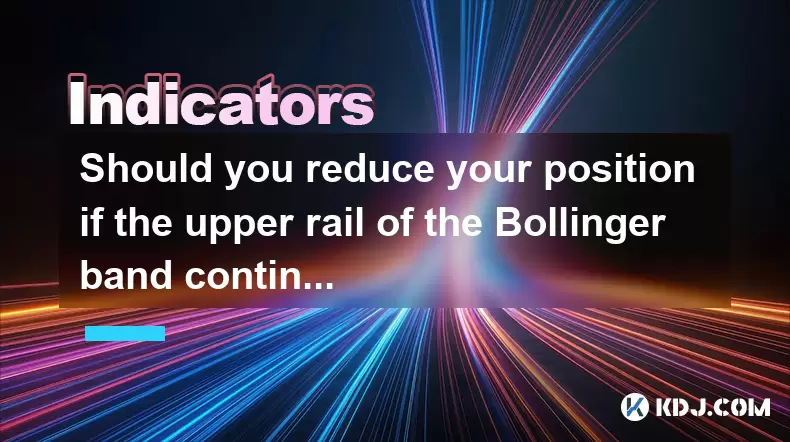
Understanding the Bollinger Band and Its Upper Rail
The Bollinger Band is a widely used technical indicator in cryptocurrency trading. It consists of three lines: a simple moving average (SMA) in the center, with two outer bands representing standard deviations above and below the SMA. The upper rail specifically reflects overbought conditions when price approaches or touches it repeatedly.
In crypto markets, which are known for high volatility, hitting the upper rail of the Bollinger band frequently can signal that an asset is overextended to the upside. This doesn't necessarily mean a reversal is imminent, but it does warrant caution, especially if other indicators or volume patterns support this view.
Why Repeated Pressure on the Upper Rail Matters
When the price of a cryptocurrency consistently touches or hovers near the upper rail, it indicates strong buying pressure. However, persistent contact without meaningful pullbacks may suggest that momentum is waning. In such cases, traders often question whether they should reduce exposure.
One key factor to consider is the width of the Bollinger Bands. If the bands are expanding rapidly, it could imply increasing volatility, which might sustain the uptrend. Conversely, if the bands are narrowing while the price remains at the upper boundary, it could hint at an impending consolidation or reversal.
Interpreting Price Action Near the Upper Rail
It's crucial to examine how the price behaves after touching the upper rail. If each touch results in lower follow-through or weaker candlestick formations, this could be a red flag. For example:
- A shooting star or spinning top forming at the upper rail suggests indecision.
- A bearish engulfing pattern appearing shortly after a touch may indicate selling pressure building up.
- A failure to break past previous highs despite reaching the upper rail again could signal weakening momentum.
These signals don’t guarantee a reversal, but they do increase the probability that the current trend is losing steam. Traders who recognize these early warning signs may choose to reduce position size to protect profits or limit potential losses.
Combining Bollinger Bands with Other Indicators
Relying solely on the Bollinger Bands for trade decisions can lead to premature exits or missed opportunities. To make more informed choices, many traders combine them with complementary tools:
- Relative Strength Index (RSI): When RSI is above 70 and the price is at the upper rail, it confirms overbought conditions. If RSI starts to trend downward while price continues upward, it may indicate a bearish divergence.
- Volume: Sudden spikes in volume as price reaches the upper rail can suggest a climax move, potentially followed by a sharp correction.
- MACD (Moving Average Convergence Divergence): A bearish crossover on the MACD line during an upper rail test adds weight to the idea that momentum is shifting.
By analyzing multiple timeframes—such as using the daily chart for trend direction and the 4-hour or 1-hour charts for entry/exit points—you can better assess whether reducing your position is prudent.
Practical Steps to Evaluate Position Reduction
If you're facing repeated tests of the upper rail of the Bollinger band, here’s a step-by-step approach to help determine whether to reduce your position:
- Analyze recent candlestick behavior near the upper rail for signs of rejection.
- Check if RSI or other oscillators confirm overbought levels or show divergence.
- Look for changes in volume patterns—especially decreasing volume on successive rallies.
- Assess support levels below the current price to understand downside risk.
- Consider partial profit-taking if the trend has extended significantly and no new catalysts are present.
Each of these steps helps build a clearer picture of market dynamics. If multiple signals align, reducing exposure—even partially—can be a strategic decision.
Managing Risk Based on Market Conditions
Cryptocurrency markets are highly sensitive to news, sentiment, and macroeconomic factors. Even if technical indicators point toward a possible reversal, external events can override short-term setups. Therefore, managing risk becomes critical when the upper rail of the Bollinger band is under consistent pressure.
Some traders set stop-loss orders just below recent swing lows to protect against sudden reversals. Others use trailing stops to lock in gains as the price moves upward. Regardless of the method, having a clear plan before entering a trade allows for disciplined execution.
Moreover, if you're holding a large position in a single cryptocurrency, frequent touches of the upper rail may serve as a reminder to reassess portfolio allocation. Reducing exposure in overbought assets and reallocating funds to undervalued or consolidating ones can enhance overall risk-adjusted returns.
Frequently Asked Questions
Q: Does hitting the upper rail always mean a reversal is coming?
A: No, hitting the upper rail simply indicates overbought conditions. Trends can persist even with repeated touches. It's important to look for additional confirmation from volume, candlestick patterns, and other indicators before expecting a reversal.
Q: Can I use Bollinger Bands effectively in sideways markets?
A: Yes, in ranging markets, the upper and lower rails often act as dynamic resistance and support. Prices tend to bounce between the bands, making it useful for range-bound trading strategies.
Q: Should I adjust the settings of the Bollinger Bands based on market conditions?
A: Some traders tweak the standard deviation or period length of the moving average to suit specific market environments. However, changing parameters too frequently can lead to inconsistent results. Backtesting any adjustments is recommended.
Q: Is it safe to enter a short position when price hits the upper rail?
A: Entering a short trade solely based on an upper rail touch is risky. Waiting for bearish candlestick patterns or divergences in momentum indicators can improve the odds of a successful short trade.
Disclaimer:info@kdj.com
The information provided is not trading advice. kdj.com does not assume any responsibility for any investments made based on the information provided in this article. Cryptocurrencies are highly volatile and it is highly recommended that you invest with caution after thorough research!
If you believe that the content used on this website infringes your copyright, please contact us immediately (info@kdj.com) and we will delete it promptly.
- SHIB, DOGE, and the Meme Coin Mania: What's Hot and What's Not?
- 2025-06-27 21:27:13
- Crypto Picks: Avalanche and Morpho Make Grayscale's Top 20, Leaving Optimism Behind!
- 2025-06-27 20:30:12
- NodeOps, Token Generation, and Binance Wallet: A Deep Dive into Binance's Evolving Ecosystem
- 2025-06-27 20:50:12
- PancakeSwap's Telegram AMA: Your Fast Pass to Crypto's Cutting Edge
- 2025-06-27 21:27:14
- Bitcoin, Memecoins, and Returns: A Wild Ride Through Crypto Town
- 2025-06-27 20:30:12
- Cryptocurrencies Under $1: Unveiling Hidden Growth Potential in 2025
- 2025-06-27 21:15:12
Related knowledge
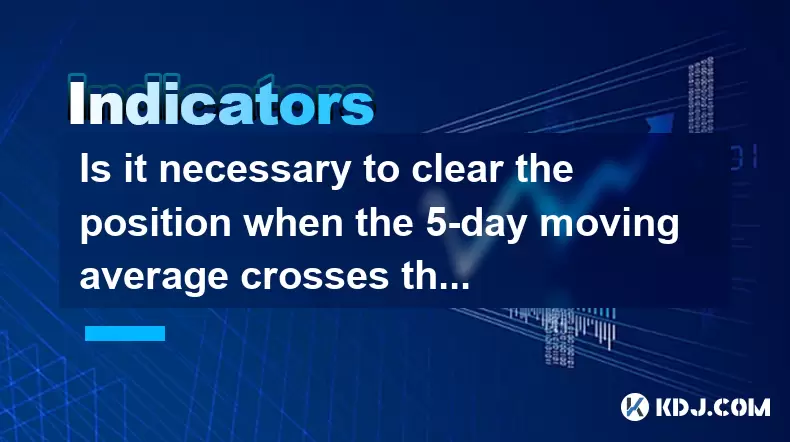
Is it necessary to clear the position when the 5-day moving average crosses the 10-day moving average?
Jun 27,2025 at 07:21pm
Understanding the 5-Day and 10-Day Moving AveragesIn the realm of technical analysis within the cryptocurrency market, moving averages play a crucial role in identifying trends and potential reversal points. The 5-day moving average (MA) and 10-day moving average are two of the most commonly used short-term indicators by traders. These tools smooth out ...
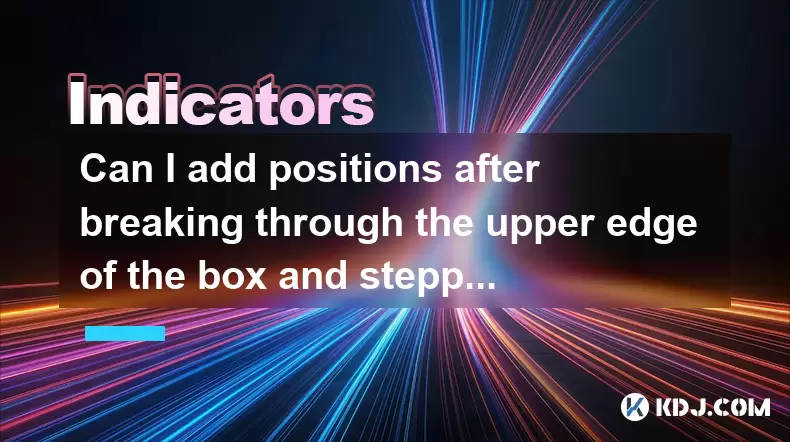
Can I add positions after breaking through the upper edge of the box and stepping back without breaking?
Jun 27,2025 at 09:56pm
Understanding the Box Breakout StrategyIn cryptocurrency trading, box breakout strategies are commonly used by technical analysts to identify potential price movements. A box, or a trading range, refers to a period where the price of an asset moves within two horizontal levels — the support (lower boundary) and resistance (upper boundary). When the pric...
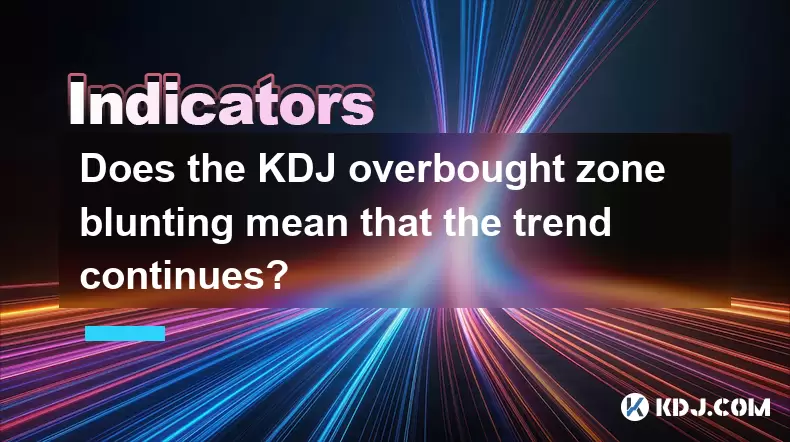
Does the KDJ overbought zone blunting mean that the trend continues?
Jun 27,2025 at 03:35pm
Understanding the KDJ Indicator in Cryptocurrency TradingThe KDJ indicator, also known as the stochastic oscillator, is a popular technical analysis tool used by traders to identify overbought or oversold conditions in asset prices. In the cryptocurrency market, where volatility is high and trends can change rapidly, understanding how to interpret the K...
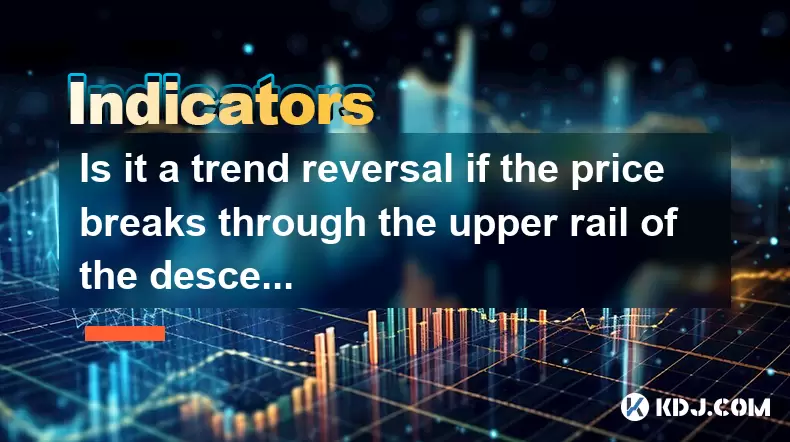
Is it a trend reversal if the price breaks through the upper rail of the descending channel and then steps back without breaking?
Jun 27,2025 at 05:35pm
Understanding the Descending Channel PatternA descending channel is a technical analysis pattern formed by two parallel downward-sloping trendlines, one acting as resistance and the other as support. This pattern typically indicates a continuation of a downtrend, where price action oscillates between these two boundaries. Traders often look for breakout...
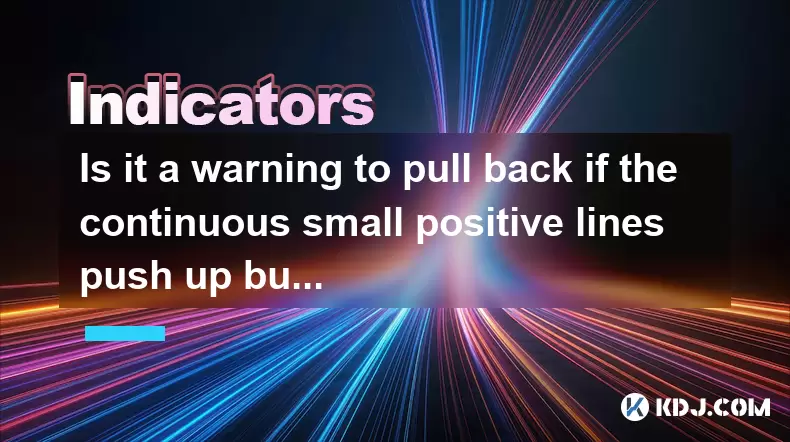
Is it a warning to pull back if the continuous small positive lines push up but the volume is insufficient?
Jun 27,2025 at 05:28pm
Understanding the Pattern: Continuous Small Positive LinesIn technical analysis, continuous small positive lines refer to a series of candlesticks where each candle closes slightly higher than its open. These candles usually have short wicks and indicate a gradual upward movement in price. Traders often interpret this pattern as a sign of steady buying ...
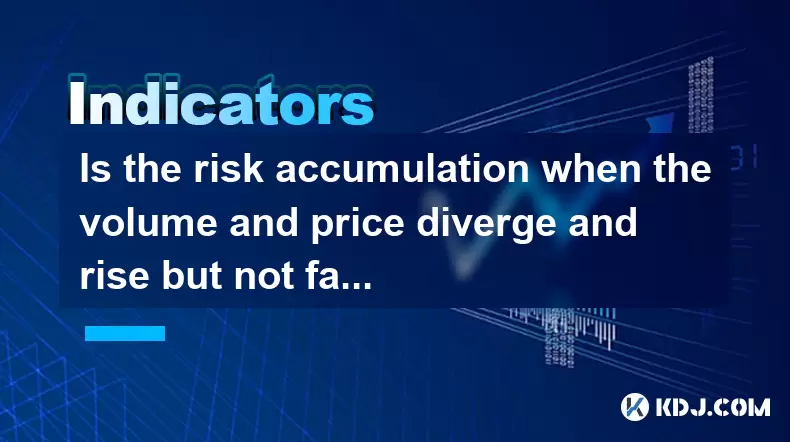
Is the risk accumulation when the volume and price diverge and rise but not fall?
Jun 27,2025 at 04:28pm
Understanding Volume and Price Divergence in Cryptocurrency TradingIn cryptocurrency trading, the relationship between volume and price plays a critical role in identifying market sentiment. When volume increases while price rises, it typically signals strong buying pressure and healthy market participation. However, when this correlation breaks—especia...

Is it necessary to clear the position when the 5-day moving average crosses the 10-day moving average?
Jun 27,2025 at 07:21pm
Understanding the 5-Day and 10-Day Moving AveragesIn the realm of technical analysis within the cryptocurrency market, moving averages play a crucial role in identifying trends and potential reversal points. The 5-day moving average (MA) and 10-day moving average are two of the most commonly used short-term indicators by traders. These tools smooth out ...

Can I add positions after breaking through the upper edge of the box and stepping back without breaking?
Jun 27,2025 at 09:56pm
Understanding the Box Breakout StrategyIn cryptocurrency trading, box breakout strategies are commonly used by technical analysts to identify potential price movements. A box, or a trading range, refers to a period where the price of an asset moves within two horizontal levels — the support (lower boundary) and resistance (upper boundary). When the pric...

Does the KDJ overbought zone blunting mean that the trend continues?
Jun 27,2025 at 03:35pm
Understanding the KDJ Indicator in Cryptocurrency TradingThe KDJ indicator, also known as the stochastic oscillator, is a popular technical analysis tool used by traders to identify overbought or oversold conditions in asset prices. In the cryptocurrency market, where volatility is high and trends can change rapidly, understanding how to interpret the K...

Is it a trend reversal if the price breaks through the upper rail of the descending channel and then steps back without breaking?
Jun 27,2025 at 05:35pm
Understanding the Descending Channel PatternA descending channel is a technical analysis pattern formed by two parallel downward-sloping trendlines, one acting as resistance and the other as support. This pattern typically indicates a continuation of a downtrend, where price action oscillates between these two boundaries. Traders often look for breakout...

Is it a warning to pull back if the continuous small positive lines push up but the volume is insufficient?
Jun 27,2025 at 05:28pm
Understanding the Pattern: Continuous Small Positive LinesIn technical analysis, continuous small positive lines refer to a series of candlesticks where each candle closes slightly higher than its open. These candles usually have short wicks and indicate a gradual upward movement in price. Traders often interpret this pattern as a sign of steady buying ...

Is the risk accumulation when the volume and price diverge and rise but not fall?
Jun 27,2025 at 04:28pm
Understanding Volume and Price Divergence in Cryptocurrency TradingIn cryptocurrency trading, the relationship between volume and price plays a critical role in identifying market sentiment. When volume increases while price rises, it typically signals strong buying pressure and healthy market participation. However, when this correlation breaks—especia...
See all articles























































































